Marjery Bryce (1891 - 1973) was a British suffragette and actor, rode dressed as Joan of Arc in WSPU parades in support of votes for women.
Marjery Bryce (1891 - 1973) was a British suffragette and actor, rode dressed as Joan of Arc in WSPU parades in support of votes for women.
Born Margaret Vincentia [1] on 18 June 1891 in Marylebone, London, [2] to politician father John Annan Bryce and mother Violet L'Estrange. [3]
Bryce was variously known as Marjery, Marjorie or Marjery Vincentia and Marjorie Annan. [4]
She had two brothers and a sister three years younger, [5] Rosalind L'Estrange, [6] known as 'Tiny'. [7] One brother, Nigel, died at the age of seventeen. Her other brother Roland, was later to be one of the commissioners in 1922 to lay out the borders for Yugoslavia. [8]
Her father was Liberal MP for the Inverness Burghs, voted against the Conciliation Bill which was to give some women the franchise and wrote letters to the press against women's suffrage. [5] Her mother, Violet held the opposite view and was a cousin to Countess Markievicz and Eva Gore-Booth, both activists for women's rights. [8]
Bryce remained single.
Bryce joined the Women's Social and Political Union (WSPU) parade at the age of nineteen [5] was portraying 'the perfect woman' [9] riding on a white horse dressed in full armour with a banner in the style of Joan of Arc, [4] [10] leading the forty thousand strong Women's Procession on 17 June 1911, [11] before George V's Coronation. Her sister Rosalind "Tiny" Bryce was dressed as a page and led the horse's bridle. [5] This demonstration was to encourage support of the proposed Conciliation Bill, which would have given the franchise to women who owned property. [7]
The image of Saint Joan was seen to represent 'the militant women's ideal....in every act of hers they recognize the same spirit as that which strengthens them to risk their liberty and endure torture for the sake of freedom'. [7] And the leaders of WSPU, Emmeline and Christabel Pankhurst, Emmeline Pethick-Lawrence and Mabel Tuke led the parade, with groups of women's trades and professions, or, like Bryce, dressed as famous women from the past. [5] Christabel in particular felt the image of Joan of Arc included the willingness to undertake physical hardship and emphasised the martial (masculine) qualities as an image of fighting for a cause of right. [12] This was summed up a ' the loveliness of simplicity, purity, courage and militancy' which Bryce was acting in this parade and was an image used by WSPU as a symbol. [13]

The Museum of London has the original copyright image of Bryce as Joan of Arc cited in many of the references above. [14]
In other suffragette parades, Joan of Arc was also portrayed by Elsie Howey. [15]
Bryce played the London stage for example, in the role of Nina Zarechnaya in The Seagull (1919), appeared in The Cloud that Lifted (1932) after performing in Other Gates in the Grafton Theatre, London in 1931, [16] and was the Red Queen in Alice in Wonderland (in 1938 and again in1947). [5]
In 1927 she took the role of 'The Spirit of Henley' in the Henley Historical Pageant. [17]
Her entry in 1939 'The Spotlight' theatrical casting directory describes her as a straight, comedy or character performer. [4]
Bryce was later known for her roles in Agatha Christie's Ten Little Niggers (1949), [18] appearing in BBC Sunday-Night Theatre (1950s) [19] and appeared in a BBC series The Bell Family (1951 ). [20]

The Women's Social and Political Union (WSPU) was a women-only political movement and leading militant organisation campaigning for women's suffrage in the United Kingdom founded in 1903. Known from 1906 as the suffragettes, its membership and policies were tightly controlled by Emmeline Pankhurst and her daughters Christabel and Sylvia. Sylvia was eventually expelled.

Marion Wallace Dunlop was a Scottish artist, author and illustrator of children's books, and Suffragette. She was the first and one of the most well known British suffrage activists to go on hunger strike on 5 July 1909, after being arrested in July 1909 for militancy. She said she would not take any food unless she was treated as a political prisoner instead of as a common criminal. Wallace Dunlop's mode of protest influenced suffragettes after her and other leaders like M. K. Gandhi and James Connolly, who also used fasting to protest British rule. She was at the centre of the Women's Social and Political Union and designed some of the most influential processions of the UK suffrage campaign, as well as designing banners for them.

Teresa Billington-Greig was a British suffragette who was one of the founders of the Women's Freedom League in 1907. She had left the Women's Social and Political Union - also known as the WSPU – as she considered the leadership led by Emmeline Pankhurst and her daughters too autocratic. In 1904, she was appointed by the WSPU as a travelling speaker for the organisation. In Autumn 1906, Billington-Greig was tasked with drumming up support for branches of WSPU in Scotland. On 25 April 1906, she unveiled a 'Votes for Women' banner from the Ladies Gallery during the debate in the House of Commons. In June 1906, she was arrested in a fracas outside of Chancellor of the Exchequer H. H. Asquith's home, and as a result was the first suffragette to be incarcerated in Holloway Prison.

A movement to fight for women's right to vote in the United Kingdom finally succeeded through acts of Parliament in 1918 and 1928. It became a national movement in the Victorian era. Women were not explicitly banned from voting in Great Britain until the Reform Act 1832 and the Municipal Corporations Act 1835. In 1872 the fight for women's suffrage became a national movement with the formation of the National Society for Women's Suffrage and later the more influential National Union of Women's Suffrage Societies (NUWSS). As well as in England, women's suffrage movements in Wales, Scotland and other parts of the United Kingdom gained momentum. The movements shifted sentiments in favour of woman suffrage by 1906. It was at this point that the militant campaign began with the formation of the Women's Social and Political Union (WSPU).
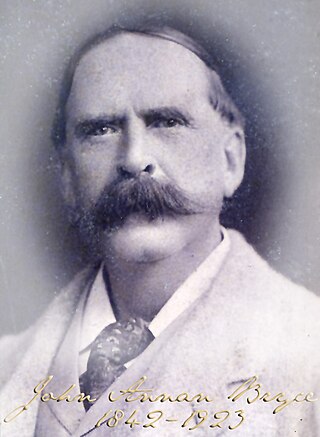
John Annan Bryce was a British businessman and Liberal Party politician.

A suffragette was a member of an activist women's organisation in the early 20th century who, under the banner "Votes for Women", fought for the right to vote in public elections in the United Kingdom. The term refers in particular to members of the British Women's Social and Political Union (WSPU), a women-only movement founded in 1903 by Emmeline Pankhurst, which engaged in direct action and civil disobedience. In 1906, a reporter writing in the Daily Mail coined the term suffragette for the WSPU, derived from suffragist, in order to belittle the women advocating women's suffrage. The militants embraced the new name, even adopting it for use as the title of the newspaper published by the WSPU.

Rose Elsie Neville Howey, known as Elsie Howey, was an English suffragette. She was a militant activist with the Women's Social and Political Union and was jailed at least six times between 1908 and 1912.

Charlotte Augusta Leopoldine Marsh, known as Charlie Marsh, was a militant British suffragette.

Edith Elizabeth Downing was a British artist, sculptor and suffragette.

Marie Venetia Caroline Brackenbury (1866–1950) was a British painter who was a militant suffragette and suffragette artist. She was jailed for demonstrating for women's rights. She followed Emmeline Pankhurst's lead as she became more militant. Her home was known as "Mouse Castle" because it looked after recovering hunger strikers. The house now has a plaque which remembers the trio of her sister, her mother and Maria. She was the younger sister of Georgina Brackenbury, also a painter and militant suffragette.
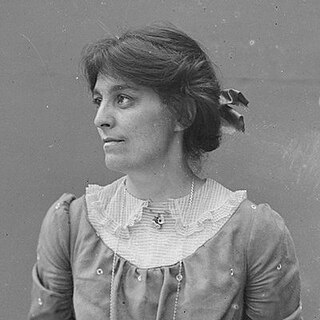
Mabel Kate Tuke born Mabel Kate Lear was a British suffragette known for her role of honorary secretary of the militant Women's Social and Political Union.

The Women's Coronation Procession was a suffragette march through London, England, on 17 June 1911, just before the Coronation of George V and Mary, demanding women's suffrage in the coronation year. The march was organised by the Women's Social and Political Union (WSPU). It was "the largest women’s suffrage march ever held in Britain and one of the few to draw together the full range of suffrage organisations".
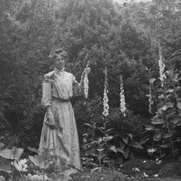
Caroline "Kitty" Kenney (1880–1952) was a sister of Annie Kenney, one of the most well-known British suffragettes to go on hunger strike, for whom the Blathwayts planted commemorative trees in their Eagle House garden in Batheaston, Somerset. Another sister, Jessie, was abroad when her involvement in explosives was discovered by the authorities.

Women's suffrage, the legal right of women to vote, has been depicted in film in a variety of ways since the invention of narrative film in the late nineteenth century. Some early films satirized and mocked suffragists and Suffragettes as "unwomanly" "man-haters," or sensationalized documentary footage. Suffragists countered these depictions by releasing narrative films and newsreels that argued for their cause. After women won the vote in countries with a national cinema, women's suffrage became a historical event depicted in both fiction and nonfiction films.

The Hunger Strike Medal was a silver medal awarded between August 1909 and 1914 to suffragette prisoners by the leadership of the Women's Social and Political Union (WSPU). During their imprisonment, they went on hunger strike while serving their sentences in the prisons of the United Kingdom for acts of militancy in their campaign for women's suffrage. Many women were force-fed and their individual medals were created to reflect this.
Helen MacRae was a British suffragette who won a Hunger Strike Medal from the Women's Social and Political Union, and was one of those who embroidered the Suffragette's Handkerchief whilst in prison.
Irene Dallas and Hilda Dallas (1878–1958) were British suffragette sisters: Hilda, an artist, designed publicity material, Irene, a protester was imprisoned for political reasons, and both sisters also boycotted the 1911 Census.
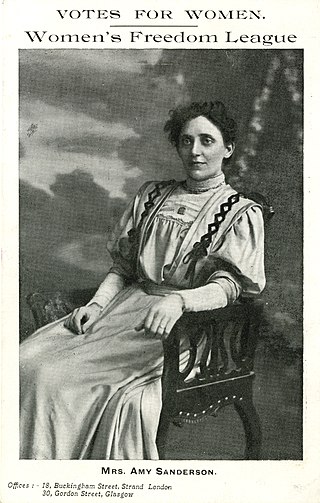
Amy Sanderson née Reid (1876-1931), was a Scottish suffragette, national executive committee member of the Women's Freedom League, who was imprisoned twice. She was key speaker at the 1912 Hyde Park women's rally, after marching from Edinburgh to London, and, with Charlotte Despard and Teresa Billington-Greig, was a British delegate to the 1908 and 1923 international women's congresses.
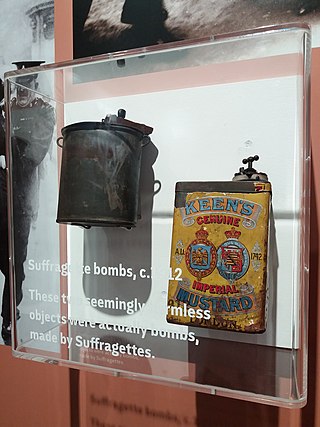
Suffragettes in Great Britain and Ireland orchestrated a bombing and arson campaign between the years 1912 and 1914. The campaign was instigated by the Women's Social and Political Union (WSPU), and was a part of their wider campaign for women's suffrage. The campaign, led by key WSPU figures such as Emmeline Pankhurst, targeted infrastructure, government, churches and the general public, and saw the use of improvised explosive devices, arson, letter bombs, assassination attempts and other forms of direct action and violence.

Hilda Mary Dallas (1878–1958) was a British artist and a suffragette who designed suffrage posters and cards and took a leadership role for the Women's Social and Political Union (WSPU). A pacifist, she raised funds from a cross-section of society, produced and designed set & costumes for the 1929 Court Theatre production of the anti-war satirical play The Rumour.